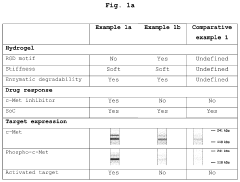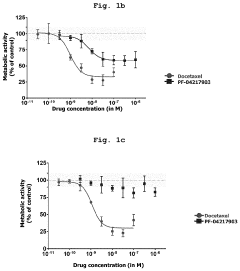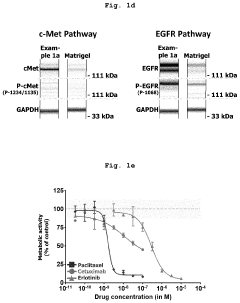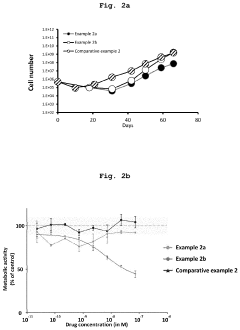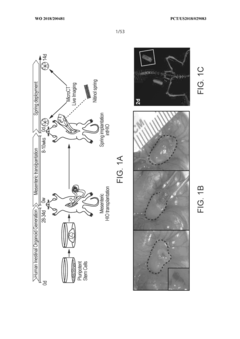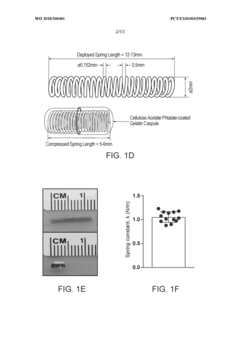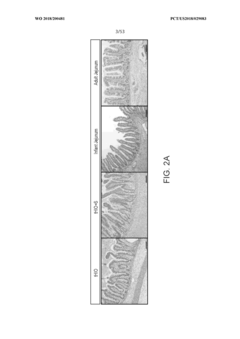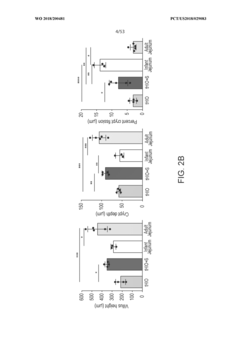Organoid Culture Systems and Electrolyte Optimization
OCT 10, 202510 MIN READ
Generate Your Research Report Instantly with AI Agent
Patsnap Eureka helps you evaluate technical feasibility & market potential.
Organoid Culture Systems Background and Objectives
Organoid culture systems represent a revolutionary advancement in biomedical research, emerging from the convergence of stem cell biology, developmental biology, and tissue engineering over the past decade. These three-dimensional cellular structures mimic the architecture and functionality of native organs, providing unprecedented opportunities for studying human development, disease modeling, drug screening, and personalized medicine applications.
The evolution of organoid technology can be traced back to the groundbreaking work on intestinal stem cells in 2009, which demonstrated that adult stem cells could self-organize into organ-like structures when provided with appropriate environmental cues. Since then, the field has expanded rapidly, with researchers successfully developing organoids representing various organs including brain, liver, kidney, pancreas, lung, and retina.
Current organoid culture systems rely heavily on extracellular matrix components, particularly Matrigel, to provide structural support and biochemical signals necessary for organoid formation and maintenance. However, these systems face significant challenges related to reproducibility, scalability, and physiological relevance. The undefined nature of many commercially available matrices introduces batch-to-batch variability, while the lack of vascularization limits organoid size and functionality.
Electrolyte composition represents a critical yet often overlooked aspect of organoid culture systems. The ionic microenvironment profoundly influences cellular behaviors including proliferation, differentiation, and morphogenesis. Conventional culture media formulations have largely relied on historical cell culture practices rather than being optimized specifically for three-dimensional organoid growth and development.
The primary objective of this research is to systematically investigate and optimize organoid culture systems with particular emphasis on electrolyte composition. We aim to develop defined, reproducible culture conditions that enhance organoid formation efficiency, structural organization, functional maturation, and long-term stability across multiple organ types.
Additional goals include establishing quantitative metrics for assessing organoid quality, identifying organ-specific electrolyte requirements, developing synthetic alternatives to biological matrices, and creating scalable culture platforms suitable for high-throughput applications. These advancements would address critical bottlenecks in current organoid technologies and facilitate their broader adoption in basic research, pharmaceutical development, and regenerative medicine.
The successful optimization of organoid culture systems and electrolyte compositions would significantly impact multiple fields, potentially accelerating drug discovery processes, reducing animal testing requirements, enabling personalized medicine approaches, and advancing our fundamental understanding of human development and disease mechanisms.
The evolution of organoid technology can be traced back to the groundbreaking work on intestinal stem cells in 2009, which demonstrated that adult stem cells could self-organize into organ-like structures when provided with appropriate environmental cues. Since then, the field has expanded rapidly, with researchers successfully developing organoids representing various organs including brain, liver, kidney, pancreas, lung, and retina.
Current organoid culture systems rely heavily on extracellular matrix components, particularly Matrigel, to provide structural support and biochemical signals necessary for organoid formation and maintenance. However, these systems face significant challenges related to reproducibility, scalability, and physiological relevance. The undefined nature of many commercially available matrices introduces batch-to-batch variability, while the lack of vascularization limits organoid size and functionality.
Electrolyte composition represents a critical yet often overlooked aspect of organoid culture systems. The ionic microenvironment profoundly influences cellular behaviors including proliferation, differentiation, and morphogenesis. Conventional culture media formulations have largely relied on historical cell culture practices rather than being optimized specifically for three-dimensional organoid growth and development.
The primary objective of this research is to systematically investigate and optimize organoid culture systems with particular emphasis on electrolyte composition. We aim to develop defined, reproducible culture conditions that enhance organoid formation efficiency, structural organization, functional maturation, and long-term stability across multiple organ types.
Additional goals include establishing quantitative metrics for assessing organoid quality, identifying organ-specific electrolyte requirements, developing synthetic alternatives to biological matrices, and creating scalable culture platforms suitable for high-throughput applications. These advancements would address critical bottlenecks in current organoid technologies and facilitate their broader adoption in basic research, pharmaceutical development, and regenerative medicine.
The successful optimization of organoid culture systems and electrolyte compositions would significantly impact multiple fields, potentially accelerating drug discovery processes, reducing animal testing requirements, enabling personalized medicine approaches, and advancing our fundamental understanding of human development and disease mechanisms.
Market Analysis of Organoid Technology Applications
The global organoid technology market is experiencing robust growth, valued at approximately $1.3 billion in 2023 and projected to reach $3.9 billion by 2028, representing a compound annual growth rate (CAGR) of 22.1%. This remarkable expansion is driven by increasing applications across multiple sectors, with pharmaceutical research and development emerging as the dominant segment, accounting for nearly 40% of the total market share.
Drug discovery and development processes have been revolutionized by organoid technology, reducing the time and cost associated with traditional methods. Major pharmaceutical companies including Roche, Merck, and Novartis have established dedicated organoid research divisions, with annual R&D investments in this field growing by 30% year-over-year since 2020.
The personalized medicine segment represents the fastest-growing application area, with a CAGR of 27.3%. Patient-derived organoids are increasingly utilized for treatment selection in oncology, particularly for colorectal, pancreatic, and breast cancers. Several specialized clinics in North America and Europe have begun implementing organoid-based precision medicine approaches, reporting improved treatment outcomes in preliminary studies.
Regionally, North America dominates the market with approximately 42% share, followed by Europe (30%) and Asia-Pacific (20%). However, the Asia-Pacific region is expected to witness the highest growth rate over the next five years due to increasing research investments in countries like China, Japan, and South Korea.
The electrolyte optimization segment within organoid culture systems represents a specialized but rapidly growing niche, currently valued at $180 million. This segment is projected to grow at 25% annually as researchers recognize the critical importance of electrolyte balance in enhancing organoid viability, functionality, and physiological relevance.
Key market challenges include high production costs, with average expenses for developing and maintaining organoid cultures approximately 3-5 times higher than traditional cell cultures. Standardization issues also persist, with significant variability in protocols affecting reproducibility across laboratories. Regulatory uncertainties regarding the use of organoids in clinical applications further complicate market expansion.
Despite these challenges, venture capital funding for organoid technology startups has surged, with over $850 million invested in 2022 alone, a 45% increase from the previous year. This influx of capital is accelerating innovation in culture systems, including advanced electrolyte optimization technologies that promise to address current limitations and expand application possibilities.
Drug discovery and development processes have been revolutionized by organoid technology, reducing the time and cost associated with traditional methods. Major pharmaceutical companies including Roche, Merck, and Novartis have established dedicated organoid research divisions, with annual R&D investments in this field growing by 30% year-over-year since 2020.
The personalized medicine segment represents the fastest-growing application area, with a CAGR of 27.3%. Patient-derived organoids are increasingly utilized for treatment selection in oncology, particularly for colorectal, pancreatic, and breast cancers. Several specialized clinics in North America and Europe have begun implementing organoid-based precision medicine approaches, reporting improved treatment outcomes in preliminary studies.
Regionally, North America dominates the market with approximately 42% share, followed by Europe (30%) and Asia-Pacific (20%). However, the Asia-Pacific region is expected to witness the highest growth rate over the next five years due to increasing research investments in countries like China, Japan, and South Korea.
The electrolyte optimization segment within organoid culture systems represents a specialized but rapidly growing niche, currently valued at $180 million. This segment is projected to grow at 25% annually as researchers recognize the critical importance of electrolyte balance in enhancing organoid viability, functionality, and physiological relevance.
Key market challenges include high production costs, with average expenses for developing and maintaining organoid cultures approximately 3-5 times higher than traditional cell cultures. Standardization issues also persist, with significant variability in protocols affecting reproducibility across laboratories. Regulatory uncertainties regarding the use of organoids in clinical applications further complicate market expansion.
Despite these challenges, venture capital funding for organoid technology startups has surged, with over $850 million invested in 2022 alone, a 45% increase from the previous year. This influx of capital is accelerating innovation in culture systems, including advanced electrolyte optimization technologies that promise to address current limitations and expand application possibilities.
Current Challenges in Organoid Culture and Electrolyte Balance
Despite significant advancements in organoid technology, several critical challenges persist in current organoid culture systems, particularly regarding electrolyte balance optimization. The primary limitation involves maintaining physiologically relevant microenvironments that accurately mimic in vivo conditions. Conventional culture systems struggle to establish proper ion gradients across organoid structures, resulting in suboptimal cellular differentiation and functionality. This challenge is particularly evident in brain, kidney, and intestinal organoids where electrolyte homeostasis plays a crucial role in tissue-specific functions.
Matrix composition represents another significant hurdle, as current extracellular matrices lack the dynamic properties of native tissues. Most commercially available matrices contain fixed concentrations of electrolytes that cannot adapt to the changing needs of developing organoids. This static nature fails to support the complex ion exchange processes essential for proper organoid maturation and function, leading to premature growth plateaus and limited longevity in culture.
Technical difficulties in real-time monitoring of electrolyte concentrations within organoid microenvironments further complicate optimization efforts. Current analytical methods often require sample destruction or provide only endpoint measurements, preventing continuous assessment of dynamic electrolyte changes during organoid development. This knowledge gap significantly hinders the development of responsive culture systems that could adjust electrolyte composition based on organoid needs.
Scalability issues present additional challenges, as electrolyte optimization protocols that work for small-scale organoid cultures frequently fail when scaled up for higher-throughput applications or larger organoid systems. The surface area-to-volume ratios change dramatically with scale, affecting diffusion kinetics and electrolyte distribution throughout the culture system. This inconsistency creates barriers to industrial and clinical applications requiring reproducible, large-scale organoid production.
Batch-to-batch variability in culture components further complicates standardization efforts. Variations in electrolyte content between different lots of culture media and matrix materials lead to inconsistent organoid development, making it difficult to establish reliable protocols for electrolyte optimization. This variability particularly affects complex organoids that require precise ionic conditions for proper tissue patterning and cellular organization.
The integration of vascular-like structures for improved nutrient and electrolyte delivery remains an unresolved challenge. Without effective vascularization, larger organoids develop necrotic cores due to limited diffusion of nutrients and electrolytes to central regions. Current approaches using microfluidic systems show promise but have yet to achieve the sophisticated branching networks necessary for comprehensive electrolyte distribution throughout complex organoid structures.
Matrix composition represents another significant hurdle, as current extracellular matrices lack the dynamic properties of native tissues. Most commercially available matrices contain fixed concentrations of electrolytes that cannot adapt to the changing needs of developing organoids. This static nature fails to support the complex ion exchange processes essential for proper organoid maturation and function, leading to premature growth plateaus and limited longevity in culture.
Technical difficulties in real-time monitoring of electrolyte concentrations within organoid microenvironments further complicate optimization efforts. Current analytical methods often require sample destruction or provide only endpoint measurements, preventing continuous assessment of dynamic electrolyte changes during organoid development. This knowledge gap significantly hinders the development of responsive culture systems that could adjust electrolyte composition based on organoid needs.
Scalability issues present additional challenges, as electrolyte optimization protocols that work for small-scale organoid cultures frequently fail when scaled up for higher-throughput applications or larger organoid systems. The surface area-to-volume ratios change dramatically with scale, affecting diffusion kinetics and electrolyte distribution throughout the culture system. This inconsistency creates barriers to industrial and clinical applications requiring reproducible, large-scale organoid production.
Batch-to-batch variability in culture components further complicates standardization efforts. Variations in electrolyte content between different lots of culture media and matrix materials lead to inconsistent organoid development, making it difficult to establish reliable protocols for electrolyte optimization. This variability particularly affects complex organoids that require precise ionic conditions for proper tissue patterning and cellular organization.
The integration of vascular-like structures for improved nutrient and electrolyte delivery remains an unresolved challenge. Without effective vascularization, larger organoids develop necrotic cores due to limited diffusion of nutrients and electrolytes to central regions. Current approaches using microfluidic systems show promise but have yet to achieve the sophisticated branching networks necessary for comprehensive electrolyte distribution throughout complex organoid structures.
Current Methodologies for Electrolyte Optimization in Organoid Culture
01 Electrolyte composition for organoid culture systems
Specific electrolyte compositions are crucial for maintaining organoid viability and functionality. These compositions typically include balanced concentrations of sodium, potassium, calcium, and magnesium ions that mimic physiological conditions. Optimized electrolyte formulations help maintain cellular homeostasis, support membrane potential, and facilitate cell-to-cell communication within the organoid structure, ultimately enhancing growth and differentiation of the cultured organoids.- Electrolyte composition for organoid culture media: Specific electrolyte compositions are crucial for maintaining proper ionic balance in organoid culture systems. These compositions typically include balanced concentrations of sodium, potassium, calcium, and magnesium ions that mimic physiological conditions. The precise formulation of these electrolytes can significantly impact organoid development, cellular differentiation, and functional maturation. Optimized electrolyte compositions help maintain membrane potential and support cellular signaling pathways essential for organoid growth.
- Microfluidic systems for electrolyte delivery in organoid cultures: Microfluidic platforms enable precise control over electrolyte delivery to organoid cultures. These systems can create dynamic gradients of electrolytes and maintain stable concentrations over extended periods. By integrating sensors and automated feedback mechanisms, microfluidic devices can monitor and adjust electrolyte levels in real-time, creating more physiologically relevant culture conditions. This technology allows for better simulation of in vivo environments and improved organoid development.
- Electrolyte monitoring systems for organoid cultures: Advanced monitoring systems have been developed to continuously track electrolyte concentrations in organoid culture media. These systems utilize ion-selective electrodes, optical sensors, or electrical impedance measurements to provide real-time data on electrolyte levels. The monitoring capabilities allow researchers to maintain optimal conditions and detect deviations that might affect organoid development. Integration with automated culture systems enables precise adjustments to maintain electrolyte homeostasis throughout the culture period.
- Electrolyte-enriched hydrogels for 3D organoid culture: Specialized hydrogels incorporating controlled-release electrolyte systems provide structural support and ionic regulation for organoid cultures. These biomaterials can be designed with specific electrolyte compositions that are gradually released as the gel degrades or in response to cellular demands. The three-dimensional nature of these hydrogels better mimics the native tissue environment while maintaining appropriate electrolyte concentrations throughout the matrix. This approach improves organoid morphology, cellular organization, and functional development.
- Electrolyte balance for specific organoid types: Different organoid types require specialized electrolyte formulations to recapitulate their native tissue environments. For example, intestinal organoids may require higher chloride concentrations, while brain organoids might need specific calcium-to-magnesium ratios. These tailored electrolyte profiles support tissue-specific cellular functions and developmental processes. Research has shown that optimizing electrolyte compositions based on the target organ can significantly improve organoid maturation, cellular differentiation, and functional characteristics.
02 Microfluidic systems for electrolyte delivery in organoid cultures
Microfluidic platforms enable precise control over electrolyte delivery to organoid cultures. These systems facilitate continuous perfusion of culture media with controlled electrolyte concentrations, creating physiologically relevant microenvironments. The dynamic flow of electrolytes helps remove waste products while maintaining optimal nutrient and ion concentrations around the organoids, resulting in improved organoid development and functionality compared to static culture conditions.Expand Specific Solutions03 Electrolyte monitoring and adjustment systems for organoid cultures
Real-time monitoring and adjustment of electrolyte levels in organoid culture systems ensure optimal growth conditions. These systems employ sensors to detect electrolyte concentrations and automated mechanisms to adjust levels as needed. Maintaining precise electrolyte balance is essential for organoid development, as fluctuations can affect cellular signaling pathways and tissue organization. Advanced monitoring systems help researchers maintain consistent culture conditions for reproducible organoid generation.Expand Specific Solutions04 Biomaterials with electrolyte-releasing properties for organoid culture
Specialized biomaterials that gradually release electrolytes provide sustained ionic support for organoid cultures. These materials can be incorporated into hydrogels or scaffolds to create a controlled microenvironment with stable electrolyte concentrations. The slow release of ions helps maintain physiological conditions over extended culture periods without requiring frequent media changes. Such biomaterials can be tailored to release specific electrolytes needed for particular organoid types, enhancing tissue-specific development and function.Expand Specific Solutions05 Electrolyte-based stimulation for organoid maturation
Controlled electrolyte gradients and pulsed electrolyte delivery can be used to stimulate organoid maturation and functionality. By creating transient changes in ionic concentrations, these techniques mimic physiological stimuli that occur during tissue development. Electrolyte-based stimulation has been shown to enhance cellular differentiation, promote tissue organization, and improve functional outcomes in various organoid types. This approach is particularly valuable for generating organoids with mature phenotypes that better recapitulate native tissue function.Expand Specific Solutions
Leading Research Institutions and Biotech Companies in Organoid Field
The organoid culture systems and electrolyte optimization market is currently in a growth phase, with increasing adoption across research and clinical applications. The global organoid market is estimated to reach $3.5 billion by 2027, growing at a CAGR of approximately 22%. Technologically, the field is advancing rapidly but still evolving, with varying degrees of maturity across different applications. Leading players include established life science companies like STEMCELL Technologies, Molecular Devices, and FUJIFILM, alongside specialized entities such as Organoidsciences and Cell Microsystems. Academic institutions including Harvard, Peking University, and Maastricht University are driving significant innovation through research partnerships. Chinese companies like Chuangxin International Biotechnology are emerging as important players, particularly in clinical applications, while companies like CYTOO are advancing micropattern technologies for enhanced organoid culture systems.
STEMCELL Technologies Canada, Inc.
Technical Solution: STEMCELL Technologies has developed comprehensive organoid culture systems featuring specialized media formulations and matrices that mimic in vivo microenvironments. Their IntestiCult™ Organoid Growth Medium provides defined components that support long-term expansion of intestinal organoids while maintaining physiological relevance. The company has optimized electrolyte compositions in their media to enhance organoid formation efficiency and structural integrity. Their PneumaCult™ system for airway organoids incorporates precisely balanced ionic environments that support epithelial differentiation and ciliogenesis. STEMCELL has also pioneered matrix solutions like Matrigel® alternatives that offer improved batch consistency and reduced animal-derived components, addressing key challenges in standardization of organoid cultures.
Strengths: Industry-leading expertise in stem cell biology; extensive product portfolio covering multiple organ systems; strong technical support infrastructure; consistent quality control. Weaknesses: Higher cost compared to self-made media formulations; proprietary formulations limit customization for specialized research applications; dependency on complementary matrix products increases overall experimental costs.
FUJIFILM Corp.
Technical Solution: FUJIFILM has leveraged its expertise in material sciences to develop innovative organoid culture platforms incorporating specialized cell culture surfaces with optimized charge distributions that enhance cell attachment and organoid formation. Their technology includes iMatrix recombinant laminin-based substrates specifically designed to support organoid cultures with defined electrolyte compositions. FUJIFILM's research has focused on developing synthetic hydrogels with controlled release of ions critical for organoid development, particularly addressing the challenges of maintaining calcium and magnesium homeostasis during extended culture periods. The company has also created specialized imaging-compatible culture vessels that enable real-time monitoring of organoid development while maintaining precise electrolyte environments, facilitating both research applications and potential drug screening platforms.
Strengths: Strong integration of material science expertise with biological applications; robust manufacturing capabilities ensuring product consistency; established global distribution network. Weaknesses: Relatively newer entrant to organoid-specific research compared to some academic institutions; technologies may be optimized for commercial applications rather than basic research flexibility; higher cost structure compared to traditional culture methods.
Key Innovations in Organoid Matrix and Media Composition
Method and kit for cell growth
PatentPendingUS20230043948A1
Innovation
- A method and kit using fully defined, synthetic hydrogel matrices with preselected extracellular matrix conditions that vary in biological, biophysical, and biochemical characteristics to support the growth and expansion of specific tissue types, allowing for precise drug screening and organoid formation without animal-derived components, enabling personalized medicine and regenerative applications.
Methods of making improved human intestinal organoid compositions via application of strain and human intestinal organoid compositions thereof
PatentWO2018200481A1
Innovation
- The application of mechanical strain to human intestinal organoids using a nickel-titanium spring implanted within the organoid lumen, which applies a controlled tensile force to enhance growth and maturation, combining biological and mechanical cues to promote increased villus height, crypt depth, and muscle thickness.
Regulatory Framework for Organoid-Based Research and Applications
The regulatory landscape for organoid research and applications is evolving rapidly as this technology advances from laboratory settings toward clinical applications. Currently, organoid research operates within a complex framework of regulations that vary significantly across jurisdictions. In the United States, the FDA has begun developing specific guidance for organoid-based technologies, particularly focusing on their potential use in drug screening and personalized medicine applications. The regulatory approach generally classifies organoids based on their source material and intended use, with stricter oversight for those derived from human embryonic or induced pluripotent stem cells.
European regulatory bodies, particularly the European Medicines Agency (EMA), have established working groups dedicated to addressing the unique challenges posed by organoid technologies. Their framework emphasizes ethical considerations alongside safety and efficacy requirements, particularly for organoids intended for transplantation or regenerative medicine applications. The Advanced Therapy Medicinal Products (ATMP) classification often applies to organoid-based therapies, requiring rigorous quality control and validation protocols.
Ethical oversight represents a critical component of the regulatory framework, with institutional review boards (IRBs) and ethics committees playing central roles in approving organoid research protocols. Particular attention is given to informed consent procedures for tissue donors, especially when creating patient-derived organoids. The storage and use of genetic information obtained from organoids must comply with data protection regulations such as GDPR in Europe and HIPAA in the United States.
Quality control standards for organoid culture systems are increasingly being standardized, with organizations like the International Society for Stem Cell Research (ISSCR) and the International Council for Harmonisation (ICH) developing guidelines specific to three-dimensional cellular models. These standards address concerns regarding reproducibility, batch-to-batch variation, and electrolyte optimization in culture media—factors critical for regulatory compliance in both research and commercial applications.
For commercial applications, regulatory pathways typically require demonstration of batch consistency, particularly regarding electrolyte composition in culture media, which directly impacts organoid functionality and physiological relevance. Companies developing organoid-based products must establish robust quality management systems that monitor and control electrolyte parameters throughout the manufacturing process.
Looking forward, regulatory agencies are working toward harmonized international standards for organoid technologies, recognizing their potential transformative impact on drug development and personalized medicine. These emerging frameworks aim to balance innovation with appropriate safeguards, acknowledging the unique challenges posed by technologies that replicate human organ functionality in vitro.
European regulatory bodies, particularly the European Medicines Agency (EMA), have established working groups dedicated to addressing the unique challenges posed by organoid technologies. Their framework emphasizes ethical considerations alongside safety and efficacy requirements, particularly for organoids intended for transplantation or regenerative medicine applications. The Advanced Therapy Medicinal Products (ATMP) classification often applies to organoid-based therapies, requiring rigorous quality control and validation protocols.
Ethical oversight represents a critical component of the regulatory framework, with institutional review boards (IRBs) and ethics committees playing central roles in approving organoid research protocols. Particular attention is given to informed consent procedures for tissue donors, especially when creating patient-derived organoids. The storage and use of genetic information obtained from organoids must comply with data protection regulations such as GDPR in Europe and HIPAA in the United States.
Quality control standards for organoid culture systems are increasingly being standardized, with organizations like the International Society for Stem Cell Research (ISSCR) and the International Council for Harmonisation (ICH) developing guidelines specific to three-dimensional cellular models. These standards address concerns regarding reproducibility, batch-to-batch variation, and electrolyte optimization in culture media—factors critical for regulatory compliance in both research and commercial applications.
For commercial applications, regulatory pathways typically require demonstration of batch consistency, particularly regarding electrolyte composition in culture media, which directly impacts organoid functionality and physiological relevance. Companies developing organoid-based products must establish robust quality management systems that monitor and control electrolyte parameters throughout the manufacturing process.
Looking forward, regulatory agencies are working toward harmonized international standards for organoid technologies, recognizing their potential transformative impact on drug development and personalized medicine. These emerging frameworks aim to balance innovation with appropriate safeguards, acknowledging the unique challenges posed by technologies that replicate human organ functionality in vitro.
Ethical Considerations in Organoid Research and Commercialization
The ethical landscape surrounding organoid research and commercialization presents complex challenges that require careful consideration as this technology advances. Organoid culture systems, particularly those involving electrolyte optimization, raise significant ethical questions regarding the source of human cells, informed consent protocols, and the potential commodification of biological materials derived from donors.
The use of human tissue for organoid development necessitates robust consent frameworks that adequately inform donors about how their biological materials may be used in research and potential commercial applications. Current consent practices often fail to address the long-term storage, genetic modification, or commercial exploitation of derived organoids, creating ethical ambiguities that must be resolved through improved regulatory frameworks.
Privacy concerns emerge prominently when considering that organoids retain genetic information from their source donors. As organoid culture systems become more sophisticated through electrolyte optimization techniques, these models increasingly reflect donor-specific characteristics, potentially revealing sensitive health information. This raises questions about data protection, anonymization protocols, and the right to genetic privacy in commercial research contexts.
The commercialization pathway for organoid technologies introduces additional ethical tensions between public health benefits and profit motives. Patent landscapes surrounding optimized culture systems may restrict access to these technologies in resource-limited settings, potentially exacerbating global health inequities. Balancing intellectual property protections with equitable access remains a critical challenge for the field.
Brain organoids present particularly nuanced ethical considerations due to their potential to develop rudimentary neural activities. As electrolyte optimization enhances the functional properties of these models, questions arise regarding the moral status of increasingly complex neural organoids and appropriate limitations on their development. The scientific community must establish clear boundaries to prevent research that might inadvertently create consciousness or sentience in these systems.
Regulatory frameworks currently struggle to keep pace with rapid advancements in organoid technology. The gap between existing oversight mechanisms and cutting-edge research creates uncertainty regarding appropriate ethical standards. International harmonization of ethical guidelines specifically addressing organoid research would provide clearer direction for researchers and commercial entities while protecting donor interests and public trust.
Patient-derived organoids raise questions about benefit-sharing when research leads to profitable treatments. Establishing fair compensation models that acknowledge donor contributions while encouraging innovation represents an ongoing ethical challenge that will shape the future landscape of organoid commercialization.
The use of human tissue for organoid development necessitates robust consent frameworks that adequately inform donors about how their biological materials may be used in research and potential commercial applications. Current consent practices often fail to address the long-term storage, genetic modification, or commercial exploitation of derived organoids, creating ethical ambiguities that must be resolved through improved regulatory frameworks.
Privacy concerns emerge prominently when considering that organoids retain genetic information from their source donors. As organoid culture systems become more sophisticated through electrolyte optimization techniques, these models increasingly reflect donor-specific characteristics, potentially revealing sensitive health information. This raises questions about data protection, anonymization protocols, and the right to genetic privacy in commercial research contexts.
The commercialization pathway for organoid technologies introduces additional ethical tensions between public health benefits and profit motives. Patent landscapes surrounding optimized culture systems may restrict access to these technologies in resource-limited settings, potentially exacerbating global health inequities. Balancing intellectual property protections with equitable access remains a critical challenge for the field.
Brain organoids present particularly nuanced ethical considerations due to their potential to develop rudimentary neural activities. As electrolyte optimization enhances the functional properties of these models, questions arise regarding the moral status of increasingly complex neural organoids and appropriate limitations on their development. The scientific community must establish clear boundaries to prevent research that might inadvertently create consciousness or sentience in these systems.
Regulatory frameworks currently struggle to keep pace with rapid advancements in organoid technology. The gap between existing oversight mechanisms and cutting-edge research creates uncertainty regarding appropriate ethical standards. International harmonization of ethical guidelines specifically addressing organoid research would provide clearer direction for researchers and commercial entities while protecting donor interests and public trust.
Patient-derived organoids raise questions about benefit-sharing when research leads to profitable treatments. Establishing fair compensation models that acknowledge donor contributions while encouraging innovation represents an ongoing ethical challenge that will shape the future landscape of organoid commercialization.
Unlock deeper insights with Patsnap Eureka Quick Research — get a full tech report to explore trends and direct your research. Try now!
Generate Your Research Report Instantly with AI Agent
Supercharge your innovation with Patsnap Eureka AI Agent Platform!
